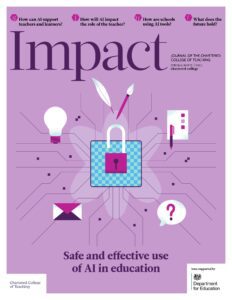Leveraging artificial intelligence to support teaching English

KIRSTY KELSEY, PRINCIPAL DEVELOPMENT LEAD, ARK CURRICULUM PLUS, UK
When working to support hundreds of teachers to embed a resourced curriculum, it is clear that teachers are working incredibly hard to tailor their lessons to the specific needs of their classes and context. What is also noticeable is that some teachers continue to feel uncertain as to how to effectively use generative artificial intelligence (GenAI) models, such as ChatGPT, as a tool to save them time in creating lesson tasks. This article considers how the use of GenAI can support teachers to produce learning tasks that are effective but also less time-consuming to create than doing them manually.
The purpose of a resourced curriculum
Teachers are faced with a plethora of decisions to make every day and, despite the overall working hours of teachers decreasing compared to previous years, almost half of teachers and leaders were found by Department for EducationThe ministerial department responsible for children’s services and education in England research to believe that their workload level was both unacceptable and out of their control (DfEDepartment for Education - a ministerial department responsible for children’s services and education in England, 2024). The same study found that one area on which teachers felt that they spent too much time was individual planning or preparation of lessons.
It could be argued that having a resourced or centralised curriculum would be an ideal solution as it would do all the heavy lifting required in coming up with a complete, logical sequence of learning. A resourced curriculum is provided either centrally, for example within a Trust of schools, or designed by an external curriculum provider. Teachers would be provided with ready-made resources, such as lesson plans, slides and assessment materials, which would then free them up to focus solely on teaching. However, lessons, of course, continue to need adaptions to meet the specific needs of the students in the classroom, depending on specific contexts, as it is not feasible or desirable to simply ‘plug and play’ central resources (Karataş et al., 2024). Moreover, teachers need to feel that they can make decisions about what is best for their students as the expert in the room, so although using a central curriculum would suggest that planning time is reduced, that is not necessarily the case. It would however mean that teachers are free to focus on the quality of their provision.
Using artificial intelligence to support planning and teach English
Despite the reduction in planning time that a resourced curriculum can provide, teachers still need to make effective adaptations to meet the needs of their students, and GenAI offers a number of benefits to teachers who are looking to improve the quality of their lessons. Students can experience learning that is more personalised (Su and Yang, 2023) – for example, teachers could use GenAI to create a set of instructions for a specific task or assist in breaking down the task into manageable chunks, and they could use it to write model answers for students based on their stage of learning. Responses could then be tailored to different reading ages or abilities, depending on the context of the class. Additionally, GenAI can be used not only to save time doing the same activities that teachers would normally do, such as writing sentence stems or starter tasks, but also to include activities that, normally, would be prohibitively time-consuming to produce – for example, providing students with various essays to rank and discuss the merits of (Roy et al., 2024).
Although there are potentially limitless ways in which teachers could use GenAI, it is important that teachers have an effective process to follow to ensure that the content generated is of value. In the example in Table 1, a teacher would like a class of Year 8 students to write an essay on how the character Napoleon has taken over the farm in Animal Farm by George Orwell. Using the reflection questions, an effective prompt or set of prompts can be engineered to guide a teacher through generating materials that could support their students in accomplishing this task.
Table 1: Example generative AI prompts for a Year 8 English lesson
| Reflective questions | AI prompt |
| What is important that students know and remember? | ‘You are an expert teacher planning for a Year 8 English class on Animal Farm by George Orwell. The class is of mixed ability*. The students will be writing an essay on how Napoleon has taken over the farm.’
‘Write a short summary of the character Napoleon.’ ‘What key quotations would you focus on to show Napoleon taking control of Animal Farm?’ |
| What misconceptions could there be?
Where could there be gaps in knowledge? |
‘What misconceptions might students have about the essay question?’
‘Create a list of quotations from Animal Farm that best show how Napoleon made himself the leader of the farm.’ |
| What might students find difficult? | ‘What language and structural features would you encourage pupils to pick out from each of these and why?’
‘Write a model answer for the essay question.’ |
| How can you modify your explanations? | ‘Write a set of instructions that I can give to this class about how to approach an essay question. I want them to begin each paragraph with a topic question, include an embedded quotation and write about the writer’s methods and purpose.’ |
*It can be beneficial to provide some specific context to help to fine-tune the responses.
Drawbacks
GenAI has been programmed to very proficiently mimic almost any specific genre or tone that it is prompted to adopt. This can be problematic because it makes it difficult to spot errors in content, of which there can often be many. AI engines like ChatGPT are not designed to tell you that they do not know something or that they aren’t sure, so instead will produce ‘hallucinations’ (a response with false or incorrect information presented as fact). The information will in some way seem plausible and easy to miss without the scrutiny of an expert. The teacher therefore plays a vital role in checking any content that is generated to ensure its validityIn assessment, the degree to which a particular assessment measures what it is intended to measure, and the extent to which proposed interpretations and uses are justified and accuracy.
Related to this is that some teachers lack the understanding of and trust in AI systems that they need in order to feel confident about the quality of the work they create using AI systems, and there is a need for training to be available to show teachers how accurately their query is likely to be answered, as well as a foundation in how the model operates (Nazaretsky et al., 2022). GenAI being successfully leveraged for effective adaptations is dependent on the competency of the teacher in using these tools (Karataş and Yüce, 2024). Additionally, there has been a noted correlation between the level of experience that a teacher has professionally and being able to effectively adapt their lessons to meet the needs of students (Karataş et al., 2024), so it seems imperative that access to professional development for both effective curriculum adaptation and GenAI is provided to teachers (Wang, 2023), in order that they might be able to make the best use of the technology available to them.
Conclusion
While the combination of a resourced curriculum and GenAI presents teachers with opportunities to streamline lesson planning and enhance personalisation for students, it is not without challenges. Teachers remain central to ensuring the quality and accuracy of resources produced using GenAI. Their expertise in adapting content to meet the needs of their classes, coupled with appropriate professional development is crucial. By leveraging these tools effectively, teachers can balance efficiency and quality, ultimately focusing more on delivering impactful education that resonates with their students.
The examples of AI use and specific tools in this article are for context only. They do not imply endorsement or recommendation of any particular tool or approach by the Department for Education or the Chartered College of Teaching and any views stated are those of the individual. Any use of AI also needs to be carefully planned, and what is appropriate in one setting may not be elsewhere. You should always follow the DfE’s Generative AI In Education policy position and product safety expectations in addition to aligning any AI use with the DfE’s latest Keeping Children Safe in Education guidance. You can also find teacher and leader toolkits on gov.uk .
- Department for Education (DfE) (2024) Working lives of teachers and leaders: Wave 3: Summary report. Available at: https://assets.publishing.service.gov.uk/media/67852c953a9388161c5d2335/Wave_3_Summary_Report.pdf (accessed 3 April 2025).
- Karataş F, Eriçok B and Tanrikulu L (2024) Reshaping curriculum adaptation in the age of artificial intelligence: Mapping teachers’ AI-driven curriculum adaptation patterns. British Educational Research Journal 51(1): 154–180.
- Karataş F and Yüce E (2024) AI and the future of teaching: Preservice teachers’ reflections on the use of artificial intelligence in open and distributed learning. The International Review of Research in Open and Distributed Learning 25(3): 304–325.
- Nazaretsky T, Ariely M, Cukurova M et al. (2022) Teachers’ trust in AI-powered educational technology and a professional development program to improve it. British Journal of Educational Technology 53(4): 914–931.
- Roy P, Poet H, Staunton R et al. (2024) ChatGPT in lesson preparation: A Teacher Choices trial: Evaluation report. Education Endowment Foundation. Available at: https://d2tic4wvo1iusb.cloudfront.net/production/documents/projects/chatgpt_in_lesson_planning_-_evaluation_report.pdf?v=1740668989 (accessed 3 April 2025).
- Su J and Yang W (2023) Unlocking the power of ChatGPT: A framework for applying generative AI in education. ECNU Review of Education 6(3): 355–366.
- Wang Y (2023) When artificial intelligence meets educational leaders’ data-informed decision-making: A cautionary tale. Studies in Educational Evaluation 69: 100872.










